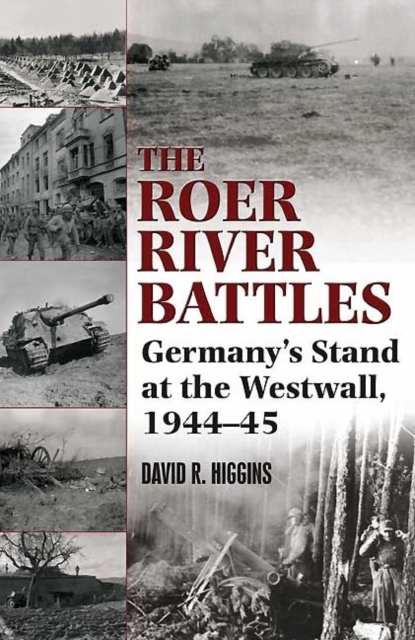
The Roer River Battles : Germany's Stand at the Westwall, 1944-45 Hardback
by David R. Higgins
Hardback
- Information
Description
A selection of the Military Book ClubFollowing the Allied breakout from the Normandy beachhead in July 1944, the vaunted German Army seemed on the verge of collapse.
As British and US forces fanned out across northwestern France, enemy resistance unexpectedly dissolved into a headlong retreat to the German and Belgian borders.
In early September an elated Allied High Command had every expectation of continuing their momentum to cripple the enemy's warmaking capability, by capturing the Ruhr industrial complex and plunging into the heart of Germany.
After a brief pause to allow for resupply, Courtney Hodge's First Army prepared to punch through the ominous but largely outdated Westwall (Siegfried Line) surrounding Aachen.
During the lull in combat operations, however, German commanders such as the "lion of defense," Walter Model, continued to reorganize depleted units and mount an increasingly potent defense.
Although the German Replacement Army funneled considerable numbers to the front, they all too often strained an overburdened supply system and did not greatly enhance existing combat formations.
More important was that the panzer divisions, once thought irretrievably destroyed, were resupplied and reinvigorated.
When the Allied offensive resumed it ran into a veritable brick wall gains measured in yards, not miles, if any were made at all.While combatants from both sides suffered equally in an urbanized environment of pillbox-infested hills, impenetrable forests, and freezing rain, the Germans were on the defensive and better able to inflict casualties out of proportion to their own.
For the US First Army, what was originally to be a walk-through turned into a frustrating six-month campaign that decimated infantry and tank forces alike.
The Broad Front, as opposed to a Schwerpunkt strategy, resulted in the demise of many a citizen-soldier.
Drawing on primary Wehrmacht and US sources, including battle analysis and daily situation and after-action reports, The Roer River Battles provides insight into the desperate German efforts to keep a conquering enemy at the borders of their homeland.
Tactical maps down to battalion level help clarify the very fluid nature of the combat.
Combined, they serve to explain not just how, but why decisions were made and events unfolded, and how reality often differed from doctrine in one of the longest US campaigns of World War II.REVIEWS well organized, concise, and easy to understand both enjoyable to read and a great addition to any military history buff s library and well as the scholar.
It would be a great addition to a community or university library as well.
Kepler s Military History, 09/2010 Organized chronologically from September 1944 to February 1945, this military history describes both Allied and German operational planning after the German retreat from France, recounts the protracted battles at Aachen and Hurtgen Forest, and ends with the successful crossing of the Roer River.
A few b&w photographs are provided, and maps depict regiment positions.
Book News, 10/20/2010 well researched and documented IPMS, 10/21/2010 Optimism for a rapid Allied victory ran high after the successful landings at Normandy in June 1944, but soon dissolved in the ensuing months as retreating German forces began to reorganize and put up a stiffening resistance to the Allied advance across Western Europe. . . . One of the main reasons for Germany s surrender in May 1945 would be the pressure applied by Allied forces that finally pushed their way to the Roer River.
World War II History good areas include descriptions of typical infantry regiments(US and German) and what they contained down to squad level and descriptions of tactics Miniature War games, 01/2011"
Information
-
Unavailable
- Format:Hardback
- Pages:288 pages, 16-pg photo section, maps
- Publisher:Casemate Books
- Publication Date:15/08/2010
- Category:
- ISBN:9781935149293
Information
-
Unavailable
- Format:Hardback
- Pages:288 pages, 16-pg photo section, maps
- Publisher:Casemate Books
- Publication Date:15/08/2010
- Category:
- ISBN:9781935149293